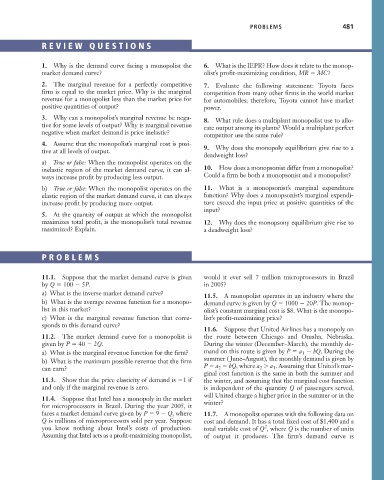Page 507 - Microeconomics, Fourth Edition
P. 507
c11monopolyandmonopsony.qxd 7/14/10 7:58 PM Page 481
PROBLEMS 481
REVIEW QUESTIONS
1. Why is the demand curve facing a monopolist the 6. What is the IEPR? How does it relate to the monop-
market demand curve? olist’s profit-maximizing condition, MR MC?
2. The marginal revenue for a perfectly competitive 7. Evaluate the following statement: Toyota faces
firm is equal to the market price. Why is the marginal competition from many other firms in the world market
revenue for a monopolist less than the market price for for automobiles; therefore, Toyota cannot have market
positive quantities of output? power.
3. Why can a monopolist’s marginal revenue be nega- 8. What rule does a multiplant monopolist use to allo-
tive for some levels of output? Why is marginal revenue cate output among its plants? Would a multiplant perfect
negative when market demand is price inelastic?
competitor use the same rule?
4. Assume that the monopolist’s marginal cost is posi-
tive at all levels of output. 9. Why does the monopoly equilibrium give rise to a
deadweight loss?
a) True or false: When the monopolist operates on the
inelastic region of the market demand curve, it can al- 10. How does a monopsonist differ from a monopolist?
ways increase profit by producing less output. Could a firm be both a monopsonist and a monopolist?
b) True or false: When the monopolist operates on the 11. What is a monopsonist’s marginal expenditure
elastic region of the market demand curve, it can always function? Why does a monopsonist’s marginal expendi-
increase profit by producing more output. ture exceed the input price at positive quantities of the
input?
5. At the quantity of output at which the monopolist
maximizes total profit, is the monopolist’s total revenue 12. Why does the monopsony equilibrium give rise to
maximized? Explain. a deadweight loss?
PROBLEMS
11.1. Suppose that the market demand curve is given would it ever sell 7 million microprocessors in Brazil
by Q 100 5P. in 2005?
a) What is the inverse market demand curve?
11.5. A monopolist operates in an industry where the
b) What is the average revenue function for a monopo- demand curve is given by Q 1000 20P. The monop-
list in this market? olist’s constant marginal cost is $8. What is the monopo-
c) What is the marginal revenue function that corre- list’s profit-maximizing price?
sponds to this demand curve?
11.6. Suppose that United Airlines has a monopoly on
11.2. The market demand curve for a monopolist is the route between Chicago and Omaha, Nebraska.
given by P 40 2Q. During the winter (December–March), the monthly de-
a) What is the marginal revenue function for the firm? mand on this route is given by P a 1 bQ. During the
summer ( June–August), the monthly demand is given by
b) What is the maximum possible revenue that the firm
can earn? P a 2 bQ, where a 2 a 1 . Assuming that United’s mar-
ginal cost function is the same in both the summer and
11.3. Show that the price elasticity of demand is 1 if the winter, and assuming that the marginal cost function
and only if the marginal revenue is zero. is independent of the quantity Q of passengers served,
will United charge a higher price in the summer or in the
11.4. Suppose that Intel has a monopoly in the market
for microprocessors in Brazil. During the year 2005, it winter?
faces a market demand curve given by P 9 Q, where 11.7. A monopolist operates with the following data on
Q is millions of microprocessors sold per year. Suppose cost and demand. It has a total fixed cost of $1,400 and a
2
you know nothing about Intel’s costs of production. total variable cost of Q , where Q is the number of units
Assuming that Intel acts as a profit-maximizing monopolist, of output it produces. The firm’s demand curve is

